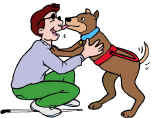|
|
|||||||||||||||||||||||||||||||||||||||||||||||
|
|
|||||||||||||||||||||||||||||||||||||||||||||||
Air travel with a service animal
Airline carriers must permit service animals with appropriate identification to accompany an individual with a disability on a flight. Identification can include documentation, a harness, or simply the verbal assurance of the passenger using the animal. Also, bring along the dog's health certificates with proof of vaccinations, and make sure you've checked out any international requirements when traveling overseas. When booking your ticket, make sure to notify your travel or ticket agent that a service dog will be accompanying you in the cabin area. It is also helpful to provide the dog's size and weight. The agent can then assist you in determining the most appropriate seating on the scheduled aircraft. If you can, travel on direct, non-stop flights. Passengers with a service animal cannot be denied any seat, unless the animal obstructs an aisle or other area that must remain clear in case of an emergency evacuation. Deciding which seat is best for a person traveling with a service animal depends on several factors. Each aircraft model may be designed differently ; floor space, bulkhead size and the amount of room under the seats can vary. Smaller dogs can usually fit under airline seats, which may provide them with a more secure ride. However, for larger dogs, bulkhead seats may be a better option. Finding the right seat is important, but there are other issues to be aware of when traveling with your service animal. Harnesses, collars and leashes can set off the alarms at security gates. Security guards who are not familiar with service dogs may be uncertain how to handle the situation. One solution is to put your dog on a "sit-stay" using a long leash, while you pass through the security gate, and then call the dog to you. This will make clear that it is the dog's harness which is setting off the alarm. Try to avoid sedating your dog as drug reactions may differ at high altitudes and can lead to illness. Also, do not feed your service animal just before departure, especially on longer journeys. Moreover, for everyone's comfort, relieve the dog prior to boarding. Travelers with guide dogs qualify for pre-boarding. Boarding first can be both easier on the dog, you and the other passengers, as well as making any possible seating changes easier to perform. Once you've gotten to your seat, it is recommended by many that the dog's harness be removed. This allows the dog better ease of movement and avoids the harness' catching on objects around the seat.
|
|
||||||||||||||||||||||||||||||||||||||||||||||
|
|
|||||||||||||||||||||||||||||||||||||||||||||||





